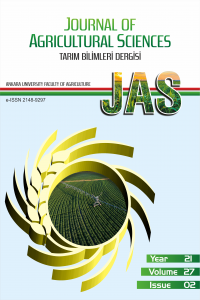Genetic Diversity and Phylogenetic Relatıonshıps of Turkish Local Popcorn (Zea mays everta) Populations By Simple Sequence Repeats (SSRs)
Genetic Diversity and Phylogenetic Relatıonshıps of Turkish Local Popcorn (Zea mays everta) Populations By Simple Sequence Repeats (SSRs)
Genetic diversity, landrace, molecular characterization popcorn, ssr,
___
- Aci M M, Revilla P, Morsli A, Djemel A, Belalia N, Kadri Y, Khelifi-Saloui M, Ordás B & Khelifi L (2013). Genetic diversity in Algerian maize (Zea mays L.) landraces using SSR markers. Maydica, 58., 304-310.
- Adjanohoun A, Allagbe M, Noumavo P A, Gotoechan-Hodonou H, Sikirou R, Dossa K K, GleleKakaï R, Kotchoni S O & Baba-Moussa L (2011). Effects of plant growth promoting rhizobacteria on field grown maize. Journal of Animal & Plant Sciences, 11(3), 1457-1465.
- Atanda A S & Olaoye G (2017). Multiplex-Ready PCR assay of SSR marker diversity among quality protein maize inbred parental lines. South African Journal of Plant and Soil, 34 (2), 149-154.
- Comertpay G (2008). Yerel mısır populasyonlarının morfolojik ve DNA molekuler isaretleyicilerinden SSR teknigi ile karakterizasyonu. Cukurova Universitesi, Fen Bilimleri Enstitusu, Tarla Bitkileri Ana Bilim Dalı, Doktora Tezi, Adana.
- Doyle J J & Doyle J L (1987). A rapid DNA isolation procedure for small quantities of fresh leaf tissue. Phytochemical Bulletin, v.19, p.11-15.
- Eschholz T W, Stamp P, Peter R, Leipner J & Hund A (2010). Genetic structure and history of swiss maize (Zea mays L. ssp. mays) landraces. Genetic Resources and Crop Evolution, 57(1), 71-84.
- Frankel O H (1972). The significance, utilization and conservation of crop genetic resources. FAO, Rome.
- Gauthier P, Gouesnard B, Dallard J, Redaelli R, Rebourg C, Charcosset A, Boyat A (2002). RFLP diversity and relationships among traditional european maize populations. Theoretical and Applied Genetics, 105(1), 91-99.
- Kimura M & Crow J F (1964). The Number of alleles that can be maintained in a finite population. Genetics, 49(4), 725.
- Laborda P R, Oliveira K M, Garcia A A F, Paterniani M E A G Z, De Souza A P (2005). Tropical maize germplasm: What can we say about its genetic diversity in the light of molecular markers? Theoretical and Applied Genetics, 111(7), 1288-1299.
- Lewontin R C (1972). The Apportionment of human diversity. Evolutionary Biology, 6(381), e398.
- Liu W S, Dong M, Song Z P, Wei W (2009). Genetic diversity pattern of Stipapurpurea populations in the hinterland of Qinghai-Tibet Plateau. Annals of Applied Biology, 154: 57–65.
- McDermott J M, McDonald B A (1993). Gene flow in plant pathosystems. Annual Review of Phytopathology, 31(1), 353-373.
- Molin D, Coelho C J, Máximo D S, Ferreira F S, Gardingo J R, Matiello R R (2013). Genetic diversity in the germplasm of tropical maize landraces determined using molecular markers. Genetics and Molecular Research, 12(1),99-114.
- Nei M (1972). Genetic distance between populations. The American Naturalist, 106(949), 283.
- Nei M (1973). Analysis of gene diversity in subdivided populations. Proceedings of the National Academy of Sciences, 70(12), 3321.
- Nei M (1978). The theory of genetic distance and evolution of human races. Japanese Journal of Human Genetics, 23(4), 341.
- Nei M (1987). Genetic distance and molecular phylogeny. Population genetics and fishery management, 193, p.223.
- Ribeiro C A G, Pinto M D O, Maciel T E F, Pastina M M, Barros E G D, Guimarães C T (2017). Universal tail sequence-SSR applied to molecular characterization of tropical maize hybrids. Scientia Agricola, 74(2), 163-168.
- Rohlf F J (1992). Program numerical taxonomy and multivariate analysis system. Version 1.70, New York.
- Sharma L, Prasanna B M, Ramesh B (2010). Analysis of phenotypic and microsatellite-based diversity of maize landraces in India, especially from the North East Himalayan region. Genetica, 138(6), 619-631.
- Tahir N A & Maeruf M S (2016). Assessment of salinity tolerance and SSR profile differentiation in nine maize genotypes (Zea mays L). Maydica, 61, M18.
- Vivodík M, Gálová Z, Balážová Ž, Petrovičová L (2017). Genetic variation of european maize genotypes (Zea mays L.) detected using SSR markers. Potravinarstvo Slovak Journal of Food Sciences, 11(1), 126-131.
- Warburton M L, Ribaut J M, Franco J, Crossa J, Dubreuil P, Betrán FJ (2005). Genetic characterization of 218 elite CIMMYT inbred maize lines using RFLP markers. Euphytica, 142:97–106.
- Yao Q L, Yang K C, Pan G T, Rong T Z (2008). Genetic diversity of maize (Zea mays L.) landraces from southwest China based on SSR data. J. Genet. Genomics, 34: 851-860.
- Zhang J, Guo J, Liu Y, Zhang D, Zhao Y, Zhu L, Huang Y, Zhang Z, Chen J (2016). Genome-wide association study identifies genetic factors for grain filling rate and grain drying rate in maize. Euphytica, 212(2), 201-21.
- ISSN: 1300-7580
- Yayın Aralığı: Yılda 4 Sayı
- Başlangıç: 1995
- Yayıncı: Ankara Üniversitesi
Hooman MANSOORİ, Mohammad GHORBANİ, Mohammad Reza KOHANSAL
Agronomic Performance of the Alternative Cereal Species in the Highest Plain of Turkey
Ali ÖZTÜRK, Sevnur AKKUŞ EKİNCİ, Selçuk KODAZ, Murat AYDIN
Application of Different Drying Techniques on Peach Puree
Ahmet POLAT, Onur TAŞKIN, Nazmi İZLİ
Muhammad Awais GHANİ, Amina MUSHTAQ, Khurram ZİAF, Basharat ALİ, Muhammad Muzammil JAHANGİR, Rashad Waseem KHAN, İmran KHAN, Muhammad AZAM, Anam NOOR
Determining the Most Stable Potato Genotypes Using AMMI Yield Stability Analysis Method
Ali ASGHARİ, Shiva MOHAMMADNİA, Davoud HASSANPANAH, Rahmatollah KARİMİZADEH, Ali Akbar SHOKOUHİAN
Catching Performance and Catching Efficiency of Siliconized Baits in Handline Fishery
Celalettin AYDIN, Akın Türker İLKYAZ
Current Status of Forage Crops Cultivation and Strategies for the Future in Turkey: A Review
Ahmet Ferit ATASOY, Ali Adnan HAYALOGLU, Huriye Gözde CEYLAN, Mehmet ÇİÇEK
Varahram RASHİDİ, Jamal RAHİMİ DARABAD, Hossein SHAHBAZİ, Mohammad MOGHADDAM VAHED, Ebrahim KHALİLVAND
